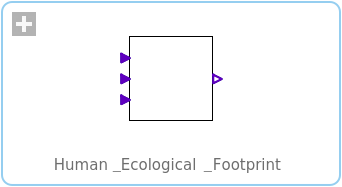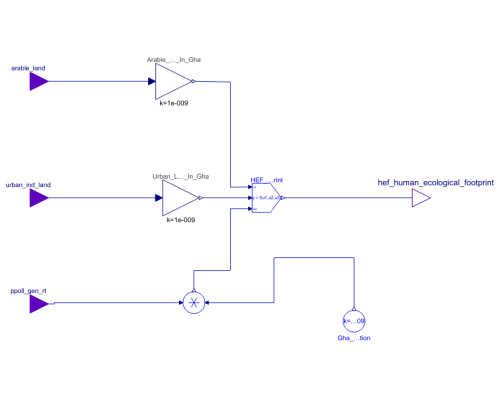WOLFRAM SYSTEM MODELER
Human_Ecological_FootprintEcological footprint |
|
Diagram
Wolfram Language
SystemModel["SystemDynamics.WorldDynamics.World3.Human_Ecological_Footprint"]

Information
The human ecological footprint is measured in hectares per person.
Connectors (4)
| urban_ind_land |
Type: MassInPort Description: Land occupied by human dwellings and industry |
|
|---|---|---|
| arable_land |
Type: MassInPort Description: Arable land |
|
| ppoll_gen_rt |
Type: MassInPort Description: Persistent pollution generation rate |
|
| hef_human_ecological_footprint |
Type: MassOutPort Description: Ecological footprint |
Components (5)
| Arable_Land_In_Gha |
Type: Gain Description: Output the product of a gain value with the input signal |
|
|---|---|---|
| Urban_Land_In_Gha |
Type: Gain Description: Output the product of a gain value with the input signal |
|
| Absorption_Land_In_Gha |
Type: Prod_2 Description: Product of two influencing factors |
|
| Gha_Per_Unit_Of_Pollution |
Type: Const Description: A constant factor |
|
| HEF_Human_Ecological_Footprint |
Type: HEF_Human_Ecological_Footprint Description: Human ecological footprint |
Used in Examples (11)
|
SystemDynamics.WorldDynamics.World3 Original WORLD3 model |
|
|
SystemDynamics.WorldDynamics.World3 More abundant non-recoverable natural resources |
|
|
SystemDynamics.WorldDynamics.World3 More accessible non-recoverable natural resources and pollution control |
|
|
SystemDynamics.WorldDynamics.World3 More accessible non-recoverable natural resources, pollution control, and land yield enhancement |
|
|
SystemDynamics.WorldDynamics.World3 More accessible non-recoverable natural resources, pollution control, land yield enhancement, and erosion protection |
|
|
SystemDynamics.WorldDynamics.World3 More accessible non-recoverable natural resources, pollution control, land yield enhancement, erosion protection, and resource efficiency |
|
|
SystemDynamics.WorldDynamics.World3 More abundant non-recoverable natural resources and birth control |
|
|
SystemDynamics.WorldDynamics.World3 More abundant non-recoverable natural resources, birth control, and stable industrial output |
|
|
SystemDynamics.WorldDynamics.World3 Combining the measures of Scenarios #6 and #8 |
|
|
SystemDynamics.WorldDynamics.World3 Influencing the future 20 years earlier |
|
|
SystemDynamics.WorldDynamics.World3 Influencing the future 10 years later |

